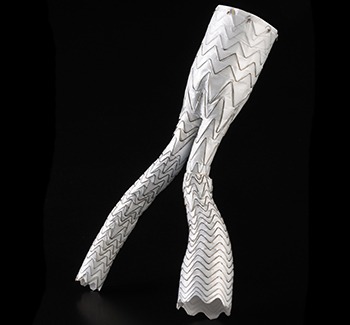
More than 250,000 patients have been treated with the Gore Excluder abdominal aortic aneurysm (AAA) end prosthesis, the company has announced. This marks a significant milestone for the device, which received CE mark in 1997, and US Food and Drug Administration (FDA) approval in 2002.
“Since completing the initial clinical trial, we have made one modification to the Gore Excluder AAA endoprosthesis design by adding a low-permeability film layer to the graft,” says Ryan Takeuchi, Aortic Business unit leader at Gore.
The Gore Excluder AAA endoprosthesis is a minimally invasive treatment option for patients with abdominal aortic aneurysms (AAA), featuring active infrarenal fixation and designed to provide migration resistance. According to a company release, the device also features exceptional limb performance due to the unique combination of expanded polytetrafluoroethylene (ePTFE) graft material and fully supported, nested, nitinol stent design to prevent kinking and occlusion. A presentation at the 2015 Vascular Annual Meeting featured a meta-analysis of several endovascular aneurysm repair (EVAR) devices that showed the Gore Excluder device limbs have the lowest incidence of occlusion at both one and three years.
Achieving several key milestones, Gore recently announced the first US implantation of the Gore Excluder thoracoabdominal branch endoprosthesis. This initial feasibility study, which has FDA consent to enrol up to 10 patients, will assess the safety of the device implantation procedure in the treatment of aortic aneurysms encroaching on or involving visceral branch vessels.
Gore also anticipates 2016 FDA approval of its Excluder liac branch endoprosthesis, as well as continued enrolment in various studies evaluating the Gore TAG thoracic branch endoprosthesis for aortic arch aneurysms.
“These trial results are remarkably similar to government-funded randomised trials, and have established certain benefits of these minimally invasive therapies to improve the health of patients. Further, in the USA OVER trial, endovascular repair reduced total healthcare costs,” says Jon Matsumura, professor and chairman, Division of Vascular Surgery at the University of Wisconsin School of Medicine, USA and public health and national principal investigator of the initial device clinical trial.
With more than 3,000 patients enrolled in the Gore Global Registry for Endovascular Aortic Treatment (GREAT), data has been collected since August 2010 on patients treated with the Gore Excluder AAA endoprosthesis as well as the Gore TAG thoracic endoprosthesis, conformable Gore TAG thoracic endoprosthesis, and most recently, the Gore Excluder iliac branch endoprosthesis. A total of 5,000 consecutive patients from up to 300 worldwide sites are to be be enrolled in the registry, and their treatment results should be tracked for 10 years.











